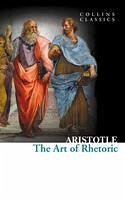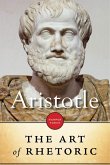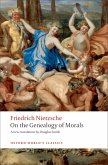Aristotle
The Art of Rhetoric (eBook, ePUB)
6,29 €
6,29 €
inkl. MwSt.
Sofort per Download lieferbar

0 °P sammeln
6,29 €
Als Download kaufen

6,29 €
inkl. MwSt.
Sofort per Download lieferbar

0 °P sammeln
Jetzt verschenken
Alle Infos zum eBook verschenken
6,29 €
inkl. MwSt.
Sofort per Download lieferbar
Alle Infos zum eBook verschenken

0 °P sammeln
Aristotle
The Art of Rhetoric (eBook, ePUB)
- Format: ePub
- Merkliste
- Auf die Merkliste
- Bewerten Bewerten
- Teilen
- Produkt teilen
- Produkterinnerung
- Produkterinnerung
- Weitere 6 Ausgaben:
- Broschiertes Buch
- Broschiertes Buch
- eBook, ePUB
- eBook, ePUB
- eBook, ePUB
- eBook, PDF

Bitte loggen Sie sich zunächst in Ihr Kundenkonto ein oder registrieren Sie sich bei
bücher.de, um das eBook-Abo tolino select nutzen zu können.
Hier können Sie sich einloggen
Hier können Sie sich einloggen
Sie sind bereits eingeloggt. Klicken Sie auf 2. tolino select Abo, um fortzufahren.

Bitte loggen Sie sich zunächst in Ihr Kundenkonto ein oder registrieren Sie sich bei bücher.de, um das eBook-Abo tolino select nutzen zu können.
HarperCollins is proud to present its incredible range of best-loved, essential classics.
- Geräte: eReader
- mit Kopierschutz
- eBook Hilfe
- Größe: 0.62MB
- FamilySharing(5)
Andere Kunden interessierten sich auch für
![The Art Of Rhetoric (eBook, ePUB) The Art Of Rhetoric (eBook, ePUB)]() AristotleThe Art Of Rhetoric (eBook, ePUB)2,03 €
AristotleThe Art Of Rhetoric (eBook, ePUB)2,03 €![The Art of Rhetoric (eBook, ePUB) The Art of Rhetoric (eBook, ePUB)]() AristotleThe Art of Rhetoric (eBook, ePUB)7,99 €
AristotleThe Art of Rhetoric (eBook, ePUB)7,99 €![On the Genealogy of Morals (eBook, ePUB) On the Genealogy of Morals (eBook, ePUB)]() Friedrich NietzscheOn the Genealogy of Morals (eBook, ePUB)0,99 €
Friedrich NietzscheOn the Genealogy of Morals (eBook, ePUB)0,99 €![On the Genealogy of Morals (eBook, ePUB) On the Genealogy of Morals (eBook, ePUB)]() Friedrich NietzscheOn the Genealogy of Morals (eBook, ePUB)9,49 €
Friedrich NietzscheOn the Genealogy of Morals (eBook, ePUB)9,49 €![On the Genealogy of Morals (eBook, ePUB) On the Genealogy of Morals (eBook, ePUB)]() Friedrich NietzscheOn the Genealogy of Morals (eBook, ePUB)6,99 €
Friedrich NietzscheOn the Genealogy of Morals (eBook, ePUB)6,99 €![The Will to Power (eBook, ePUB) The Will to Power (eBook, ePUB)]() Friedrich NietzscheThe Will to Power (eBook, ePUB)3,99 €
Friedrich NietzscheThe Will to Power (eBook, ePUB)3,99 €![The Art of Rhetoric (eBook, PDF) The Art of Rhetoric (eBook, PDF)]() AristotleThe Art of Rhetoric (eBook, PDF)7,99 €
AristotleThe Art of Rhetoric (eBook, PDF)7,99 €-
-
-
HarperCollins is proud to present its incredible range of best-loved, essential classics.
Dieser Download kann aus rechtlichen Gründen nur mit Rechnungsadresse in A, B, BG, CY, CZ, D, DK, EW, E, FIN, F, GR, HR, H, IRL, I, LT, L, LR, M, NL, PL, P, R, S, SLO, SK ausgeliefert werden.
Produktdetails
- Produktdetails
- Verlag: HarperCollins Publishers
- Erscheinungstermin: 13. September 2012
- Englisch
- ISBN-13: 9780007502646
- Artikelnr.: 37984217
- Verlag: HarperCollins Publishers
- Erscheinungstermin: 13. September 2012
- Englisch
- ISBN-13: 9780007502646
- Artikelnr.: 37984217
- Herstellerkennzeichnung Die Herstellerinformationen sind derzeit nicht verfügbar.
The Greek philosopher Aristotle (384 BC-322 BC) is, alongside Plato, who taught Aristotle, and Socrates, one of the most important figures in Western philosophy.
The Art of Rhetoric - Aristotle Translated with an Introduction and Notes
by Hugh Lawson-Tancred
Preface
Introduction:
1. The Importance of Ancient Rhetoric
2. The Historical Background to the Rhetoric
3. Rhetoric as Techne
4. Psychology in the Rhetoric
5. Style and Composition
6. The Rhetorical Legacy of Aristotle
7. The Translation
THE ART OF RHETORICSection One: Introductory
Chapter 1.1. The Nature of Rhetoric
PART ONE: DEMONSTRATIONSection Two: The Genres of Oratory
Chapter 1.2. The Definition of Rhetoric
Chapter 1.3. The Genres
Section Three: Deliberation
Chapter 1.4. The Province of Deliberation
Chapter 1.5. Happiness
Chapter 1.6. The Good and the Expedient
Chapter 1.7. Relative Expediency
Chapter 1.8. Constitutions
Section Four: Display
Chapter 1.9. Display Oratory
Section Five: Litigation
Chapter 1.10. Injustice
Chapter 1.11. Pleasure
Chapter 1.12. The Criminal Mind
Chapter 1.13. Crime and Punishment
Chapter 1.14. Relatively Serious Crimes
Chapter 1.15. Non-technical Proofs
PART TWO: EMOTION AND CHARACTERSection Six: Emotion
Chapter 2.1. The Role of Emotion and Character
Chapter 2.2. Anger
Chapter 2.3. Calm
Chapter 2.4. Friendship and Enmity
Chapter 2.5. Fear and Confidence
Chapter 2.6. Shame
Chapter 2.7. Favour
Chapter 2.8. Pity
Chapter 2.9. Indignation
Chapter 2.10. Envy
Chapter 2.11. Jealousy
Section Seven: Character
Chapter 2.12. Youth
Chapter 2.13. Old Age
Chapter 2.14. Prime
Chapter 2.15. Birth
Chapter 2.16. Wealth
Chapter 2.17. Power
PART THREE: UNIVERSAL ASPECTSSection Eight: Common Topics
Chapter 2.18. The Role of Common Topics
Chapter 2.19. The Topics of Possibility
Chapter 2.20. Example
Chapter 2.21. Maxim
Chapter 2.22. Enthymeme
Chapter 2.23. Demonstrative Common Topics
Chapter 2.24. Illusory Topics
Chapter 2.25. Refutation
Chapter 2.26. Amplification
Section Nine: Style
Chapter 3.1. Historical Preliminary
Chapter 3.2. Clarity
Chapter 3.3. Frigidity
Chapter 3.4. Simile
Chapter 3.5. Purity
Chapter 3.6. Amplitude
Chapter 3.7. Propriety
Chapter 3.8. Rhythm
Chapter 3.9. Syntax
Chapter 3.10. Wit and Metaphor
Chapter 3.11. Vividness
Chapter 3.12. Suitability to Genre
Section Ten: Composition
Chapter 3.13. Narration and Proof
Chapter 3.14. The Introduction
Chapter 3.15. Prejudice
Chapter 3.16. Narration
Chapter 3.17. Proof and Refutation
Chapter 3.18. Altercation
Chapter 3.19. The Epilogue
Notes
Bibliography
by Hugh Lawson-Tancred
Preface
Introduction:
1. The Importance of Ancient Rhetoric
2. The Historical Background to the Rhetoric
3. Rhetoric as Techne
4. Psychology in the Rhetoric
5. Style and Composition
6. The Rhetorical Legacy of Aristotle
7. The Translation
THE ART OF RHETORICSection One: Introductory
Chapter 1.1. The Nature of Rhetoric
PART ONE: DEMONSTRATIONSection Two: The Genres of Oratory
Chapter 1.2. The Definition of Rhetoric
Chapter 1.3. The Genres
Section Three: Deliberation
Chapter 1.4. The Province of Deliberation
Chapter 1.5. Happiness
Chapter 1.6. The Good and the Expedient
Chapter 1.7. Relative Expediency
Chapter 1.8. Constitutions
Section Four: Display
Chapter 1.9. Display Oratory
Section Five: Litigation
Chapter 1.10. Injustice
Chapter 1.11. Pleasure
Chapter 1.12. The Criminal Mind
Chapter 1.13. Crime and Punishment
Chapter 1.14. Relatively Serious Crimes
Chapter 1.15. Non-technical Proofs
PART TWO: EMOTION AND CHARACTERSection Six: Emotion
Chapter 2.1. The Role of Emotion and Character
Chapter 2.2. Anger
Chapter 2.3. Calm
Chapter 2.4. Friendship and Enmity
Chapter 2.5. Fear and Confidence
Chapter 2.6. Shame
Chapter 2.7. Favour
Chapter 2.8. Pity
Chapter 2.9. Indignation
Chapter 2.10. Envy
Chapter 2.11. Jealousy
Section Seven: Character
Chapter 2.12. Youth
Chapter 2.13. Old Age
Chapter 2.14. Prime
Chapter 2.15. Birth
Chapter 2.16. Wealth
Chapter 2.17. Power
PART THREE: UNIVERSAL ASPECTSSection Eight: Common Topics
Chapter 2.18. The Role of Common Topics
Chapter 2.19. The Topics of Possibility
Chapter 2.20. Example
Chapter 2.21. Maxim
Chapter 2.22. Enthymeme
Chapter 2.23. Demonstrative Common Topics
Chapter 2.24. Illusory Topics
Chapter 2.25. Refutation
Chapter 2.26. Amplification
Section Nine: Style
Chapter 3.1. Historical Preliminary
Chapter 3.2. Clarity
Chapter 3.3. Frigidity
Chapter 3.4. Simile
Chapter 3.5. Purity
Chapter 3.6. Amplitude
Chapter 3.7. Propriety
Chapter 3.8. Rhythm
Chapter 3.9. Syntax
Chapter 3.10. Wit and Metaphor
Chapter 3.11. Vividness
Chapter 3.12. Suitability to Genre
Section Ten: Composition
Chapter 3.13. Narration and Proof
Chapter 3.14. The Introduction
Chapter 3.15. Prejudice
Chapter 3.16. Narration
Chapter 3.17. Proof and Refutation
Chapter 3.18. Altercation
Chapter 3.19. The Epilogue
Notes
Bibliography
The Art of Rhetoric - Aristotle Translated with an Introduction and Notes
by Hugh Lawson-Tancred
Preface
Introduction:
1. The Importance of Ancient Rhetoric
2. The Historical Background to the Rhetoric
3. Rhetoric as Techne
4. Psychology in the Rhetoric
5. Style and Composition
6. The Rhetorical Legacy of Aristotle
7. The Translation
THE ART OF RHETORICSection One: Introductory
Chapter 1.1. The Nature of Rhetoric
PART ONE: DEMONSTRATIONSection Two: The Genres of Oratory
Chapter 1.2. The Definition of Rhetoric
Chapter 1.3. The Genres
Section Three: Deliberation
Chapter 1.4. The Province of Deliberation
Chapter 1.5. Happiness
Chapter 1.6. The Good and the Expedient
Chapter 1.7. Relative Expediency
Chapter 1.8. Constitutions
Section Four: Display
Chapter 1.9. Display Oratory
Section Five: Litigation
Chapter 1.10. Injustice
Chapter 1.11. Pleasure
Chapter 1.12. The Criminal Mind
Chapter 1.13. Crime and Punishment
Chapter 1.14. Relatively Serious Crimes
Chapter 1.15. Non-technical Proofs
PART TWO: EMOTION AND CHARACTERSection Six: Emotion
Chapter 2.1. The Role of Emotion and Character
Chapter 2.2. Anger
Chapter 2.3. Calm
Chapter 2.4. Friendship and Enmity
Chapter 2.5. Fear and Confidence
Chapter 2.6. Shame
Chapter 2.7. Favour
Chapter 2.8. Pity
Chapter 2.9. Indignation
Chapter 2.10. Envy
Chapter 2.11. Jealousy
Section Seven: Character
Chapter 2.12. Youth
Chapter 2.13. Old Age
Chapter 2.14. Prime
Chapter 2.15. Birth
Chapter 2.16. Wealth
Chapter 2.17. Power
PART THREE: UNIVERSAL ASPECTSSection Eight: Common Topics
Chapter 2.18. The Role of Common Topics
Chapter 2.19. The Topics of Possibility
Chapter 2.20. Example
Chapter 2.21. Maxim
Chapter 2.22. Enthymeme
Chapter 2.23. Demonstrative Common Topics
Chapter 2.24. Illusory Topics
Chapter 2.25. Refutation
Chapter 2.26. Amplification
Section Nine: Style
Chapter 3.1. Historical Preliminary
Chapter 3.2. Clarity
Chapter 3.3. Frigidity
Chapter 3.4. Simile
Chapter 3.5. Purity
Chapter 3.6. Amplitude
Chapter 3.7. Propriety
Chapter 3.8. Rhythm
Chapter 3.9. Syntax
Chapter 3.10. Wit and Metaphor
Chapter 3.11. Vividness
Chapter 3.12. Suitability to Genre
Section Ten: Composition
Chapter 3.13. Narration and Proof
Chapter 3.14. The Introduction
Chapter 3.15. Prejudice
Chapter 3.16. Narration
Chapter 3.17. Proof and Refutation
Chapter 3.18. Altercation
Chapter 3.19. The Epilogue
Notes
Bibliography
by Hugh Lawson-Tancred
Preface
Introduction:
1. The Importance of Ancient Rhetoric
2. The Historical Background to the Rhetoric
3. Rhetoric as Techne
4. Psychology in the Rhetoric
5. Style and Composition
6. The Rhetorical Legacy of Aristotle
7. The Translation
THE ART OF RHETORICSection One: Introductory
Chapter 1.1. The Nature of Rhetoric
PART ONE: DEMONSTRATIONSection Two: The Genres of Oratory
Chapter 1.2. The Definition of Rhetoric
Chapter 1.3. The Genres
Section Three: Deliberation
Chapter 1.4. The Province of Deliberation
Chapter 1.5. Happiness
Chapter 1.6. The Good and the Expedient
Chapter 1.7. Relative Expediency
Chapter 1.8. Constitutions
Section Four: Display
Chapter 1.9. Display Oratory
Section Five: Litigation
Chapter 1.10. Injustice
Chapter 1.11. Pleasure
Chapter 1.12. The Criminal Mind
Chapter 1.13. Crime and Punishment
Chapter 1.14. Relatively Serious Crimes
Chapter 1.15. Non-technical Proofs
PART TWO: EMOTION AND CHARACTERSection Six: Emotion
Chapter 2.1. The Role of Emotion and Character
Chapter 2.2. Anger
Chapter 2.3. Calm
Chapter 2.4. Friendship and Enmity
Chapter 2.5. Fear and Confidence
Chapter 2.6. Shame
Chapter 2.7. Favour
Chapter 2.8. Pity
Chapter 2.9. Indignation
Chapter 2.10. Envy
Chapter 2.11. Jealousy
Section Seven: Character
Chapter 2.12. Youth
Chapter 2.13. Old Age
Chapter 2.14. Prime
Chapter 2.15. Birth
Chapter 2.16. Wealth
Chapter 2.17. Power
PART THREE: UNIVERSAL ASPECTSSection Eight: Common Topics
Chapter 2.18. The Role of Common Topics
Chapter 2.19. The Topics of Possibility
Chapter 2.20. Example
Chapter 2.21. Maxim
Chapter 2.22. Enthymeme
Chapter 2.23. Demonstrative Common Topics
Chapter 2.24. Illusory Topics
Chapter 2.25. Refutation
Chapter 2.26. Amplification
Section Nine: Style
Chapter 3.1. Historical Preliminary
Chapter 3.2. Clarity
Chapter 3.3. Frigidity
Chapter 3.4. Simile
Chapter 3.5. Purity
Chapter 3.6. Amplitude
Chapter 3.7. Propriety
Chapter 3.8. Rhythm
Chapter 3.9. Syntax
Chapter 3.10. Wit and Metaphor
Chapter 3.11. Vividness
Chapter 3.12. Suitability to Genre
Section Ten: Composition
Chapter 3.13. Narration and Proof
Chapter 3.14. The Introduction
Chapter 3.15. Prejudice
Chapter 3.16. Narration
Chapter 3.17. Proof and Refutation
Chapter 3.18. Altercation
Chapter 3.19. The Epilogue
Notes
Bibliography







